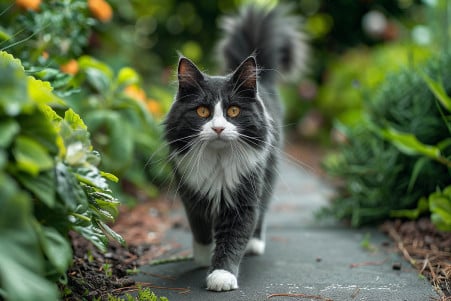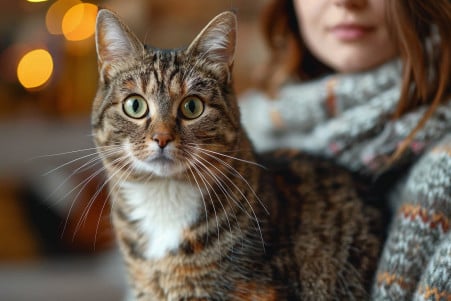Why Do Cats Arch Their Backs? Exploring the Science Behind This Feline Behavior
8 June 2024 • Updated 7 June 2024

Have you ever wondered why your cat arches its back like a black cat on Halloween? It turns out that this strange behavior can mean a number of things, from a sign of aggression to a simple stretch. When cats arch their backs in a threatening manner, they are displaying a sign of fear or aggression, fluffing up their bodies and their fur to make themselves look larger and more menacing to potential attackers. On the other hand, when a cat arches its back in a happy stretch as it walks across the room, it's just a sign of a good stretch.
We'll take a look at scientific research that explains the biological processes and possible evolutionary reasons behind this unique feline behavior. We'll also look at the ways a cat's skeletal structure, muscles, and instincts work together to help you better understand why your cat does this interesting spinal maneuver.
Why do cats arch their backs?
The Fear Aggressor: When an Arched Back Signals Danger
When a cat arches its back with raised fur, dilated pupils, and an aggressive sideways stance, it's exhibiting a defensive posture known as piloerection. This instinctive response is triggered by the release of adrenaline, causing the hair to stand on end to make the cat appear larger and more intimidating to potential threats, as explained by a veterinarian on iHeartCats.com.
Other telltale signs of fear or aggression accompanying an arched back include hissing, growling, and a tense body language. It's crucial to recognize these warning signals and give the cat space to calm down, as approaching a fearful or aggressive cat can lead to injury. According to CatsLuvUs, understanding the context, such as changes in the environment or recent stressful events, can help identify the source of the cat's distress and address the underlying causes.
Observing the cat's overall body language is key. Wag! advises never approaching a cat exhibiting an arched back combined with raised fur, as this defensive stance indicates the cat may scratch or bite if threatened further. The best approach is to stand back, remove any perceived threats, and allow the cat to retreat to a safe space until it has fully calmed down.
The Stretching Reflex: Why Cats Arch Their Backs After a Nap
Cats arch their backs as part of a full-body stretch, especially after a nap or period of rest. This reflex is part of the cat's complex body language system and allows the animal to stretch and prepare its muscles for movement, according to Ever Wondered Why Cats Arch Their Backs? Curious Facts About Cats - Part II.
In addition to helping cats maintain their flexibility, stretching also helps them improve their circulation, according to Cat in the Box LLC. Cats have very flexible spines, with almost 60 vertebrae compared to the 34 vertebrae in humans, and this flexibility allows them to arch their backs in this way. A relaxed arched back during stretching is typically accompanied by a calm demeanor, without raised fur or aggressive vocalizations.
In addition to arching their backs, cats may knead their paws, yawn, or show other signs of relaxation, such as purring or slow blinking, while they stretch. This is in contrast to the defensive arching of the back that is accompanied by piloerection, hissing, and growling, which was described in the previous section.
The Playful Arch: Excitement, Anticipation, or Play
Kittens and young cats often arch their backs during play, and the posture they assume is often bouncy and excited. According to Rover.com, this arched back position can be a sign of excitement, anticipation, or a desire to play. The arched back is often paired with other signs of play, like tail swishing, pouncing, or batting at toys.
Playing with a cat that has an arched back can help satisfy their hunting needs and strengthen your bond, according to Dr. Sarah Ellis. However, it’s important to pay attention to the cat’s body language and respond accordingly. Cats.com recommends either continuing to play or giving the cat a break if it starts to get overstimulated because the playful arch can quickly turn into a defensive arch if the cat feels overwhelmed.
The Affectionate Arch: When a Cat's Curve Signals Trust
Cats may arch their backs while being petted or receiving affection from their owners, indicating trust and contentment. According to PuAinta, this relaxed arched posture is often accompanied by purring, slow blinking, and a general calm demeanor. Arching the back during affectionate interactions can be a sign of vulnerability and a way for cats to expose their scent glands for marking.
The owner's appropriate response to this affectionate body language, like petting the cat gently, can help build trust and a positive relationship. That said, it's also important for owners to recognize when their cat is ready to end the interaction and give them space, which is noted by the Cornell University College of Veterinary Medicine.
Conclusion: Understanding the Feline Arch as a Form of Cat Communication
It is important to take into account a cat's other body language signals, such as ear position, tail movement, vocalizations, and the situation in which the behavior occurs, in order to fully understand what a cat is trying to communicate with an arched back, according to SHEBA®. For example, when a cat arches its back and the hair on its back is standing up, its pupils are dilated, and it is hissing or growling, the observer should back off and not approach or startle the cat, notes Wag!.
On the other hand, if a cat arches its back while stretching or being petted, it is generally safe to continue the interaction, but the person should respect the cat's boundaries and allow it to leave if it wants to, according to the Cornell University College of Veterinary Medicine. Meanwhile, when a cat arches its back during play, it is a sign that the cat is excited and ready to engage in interactive play, but the person should watch for signs of overstimulation and take play breaks when necessary, reports Cats.com.
Professional help from a veterinarian or animal behaviorist can be useful in addressing the fear, aggression, or pain that may be causing a cat to arch its back, according to SHEBA® and Rawz Natural Pet Food. However, by learning to understand and respond to a cat's body language, people can build a more positive and fulfilling relationship with these captivating animal companions.


